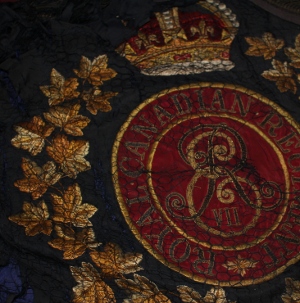Topic: The RCR


33rd Battalion
Made and presented by I.O.D.E, London, Ontario, July 21st, 1915; accompanied the unit to England and deposited in Canterbury Cathedral on Aug 26th, 1916.
142nd Battalion
Colours made by Messrs Ryrie Brothers, Toronto, and presented by Sir Adam and Lady Beck, of London, Ontario, on Aug 19th, 1915; deposited in St Paul's Cathedral, London, Ontario.
 The Royal Canadian Regiment
The Royal Canadian Regiment
Colours in Halifax. (As of the writing of the volume in 1918.)
At the end of the Appendix on Canadian Colours, the following synopsis history of The Royal Canadian Regiment was provided:
The Royal Canadian Regiment is the only regular unit in the Canadian Forces. It was first raised in December, 1883, for the purpose of instructing the Canadian Militia, and was called the Infantry School Corps. Since then it has been known as the Royal Regiment of Canadian Infantry, then the Royal Canadian Regiment of Infantry, and later by its present title.
In 1894 H.M. Queen Victoria gave her Imperial Cypher V.R.I, as a badge. The Regiment was increased during the South African War by the raising of a 2nd and 3rd Battalion; these were afterwards disbanded.
In 1885 the Regiment took part in the suppression of the North West Rebellion under General Middleton at Batoche and Cut-Knife Creek.
In 1896 (sic) it formed part of the Expedition sent up to police the New Yukon District, where it remained for two years. In 1899-1900, the 2nd Battalion fought in South Africa with the 19th Brigade, doing particularly good service at Paardeburg (sic). In 1905 the establishment was increased, when the Imperial Troops handed over the garrisoning of the fortresses at Halifax and elsewhere to Canadian Troops.
In 1914, on the outbreak of war, the Battalion relieved the 2nd Bn. Lincolnshire Regiment at Bermuda, whre it remained for eleven months.
It landed in France in November, 1915, and took part in the battle of Ypres of June, 1916, Somme, September, 1916, and Vimy, 1917. It particularly distinguished itself on the Somme and Vimy.
H.R.H. The Duke of Connaught is Colonel of the Regiment.
In 1901, H.R.H. the Duke of Cornwall and York (now H.M. King George V.) presented Colours to the Regiment at Toronto. In 1904, H.E. Lord Minto, Governor-General of Canada, presented at Ottawa a special Banner given by H.M. King Edward VII, for service in South Africa.
Note: The Colours of both the 33rd and 142nd Canadian Infantry Battalions are currently laid up in St Paul's Cathedral, London, Ontario. The orginal Colours presented to The RCR are laid up in the Bishop Cronyn Church, London Ontario.

